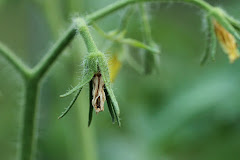With all those seed catalogs arriving, lots of tomato varieties look tempting. Which ones taste the best?
A taste test last season in Boulder, Colorado identified some favorite tomatoes. Among 40
salad tomatoes including low-rated 'Celebrity' and 'Stupice',
'Siberian' came out on top with '
Carmello' and
'Cosmonaut Volkov' close behind. Those were followed by 'Jetsetter', 'Green Zebra', 'Early Girl' and 'Valencia' that formed a respectable second tier.
For
beefsteak types, the winners out of 23 compared were far and away
'Pineapple' and
'Amana Orange'. Those receiving respectable but far fewer votes were 'Paul Robeson', 'Cherokee Purple', 'Black Krim', 'Black Sea Man', 'Brandywine' and then 'Black from Tula'.
Thirty-one
cherry types were taste tested with the winners
'Sungold' followed by
'Yellow Globe',
'Isis' and
'Green Doctors Frosted'. The second tier included 'Matt's Wild Cherry', 'Chiapas', 'Yellow Pear' and 'Green Doctors'. Respectable ratings were given to 'Wow', 'Sweet 100', 'Sunsugar' and 'Black Cherry'.
Eight
paste tomatoes were in the test with
'Plum Zebra' winning by far. And yes, standards 'San Marzano' and 'Roma' were in the test but rated very low.
This test will tell you something about how a group of people rated the taste of tomatoes grown locally. It says nothing about how productive, how early, or how disease or crack resistant these varieties are to name a few things you might be looking for. Keep in mind your own production needs when choosing seed to plant.
Photo Credit: Tomato fruit in bowls - Carl Wilson




























